Special Report
Countries Spending the Most on War

Published:
Last Updated:

China has drastically increased the size and scale of its military over the last decade. It has more than doubled its annual military expenditure in that time, spending $228 billion in 2017. Still, China’s budget is less than half the military budget of the United States. The U.S. government spent $610 billion on its armed forces in 2017, more than the next seven countries combined.
For most of its history, the United States has been at war. Since declaring independence in 1776, the country has been engaged in armed conflicts for all but 21 out of the 242 years of its existence. This near-constant state of war has led the United States to continually update its military. As the world’s largest economy, the United States can afford to spend much more on its military than any other country.
While the United States is in a league of its own, there are other major military spenders, and they can be found all around the world. The top 14 military spenders, after the U.S., can be found on five continents, and each has its own vast web of military and political alliances. Some are allies, other are bitter enemies.
Based on annual military spending estimates from the Stockholm International Peace Research Institute, or SIPRI, 24/7 Wall St. reviewed the 15 countries with the largest military expenditure in 2017.
Click here to see the 15 countries spending the most on war.
Click here to see our detailed findings and methodology.

15. Turkey
> 2017 military spending: $18.2 billion
> Military spending change, 2008-2017: +46.0%
> Expenditure as pct. of GDP: 2.2%
> Military spending per capita: $225
Due to substantial unrest with neighbors Syria and Iraq, Turkey’s military has carried out several bombing campaigns in 2017 and 2018, targeting U.S.-backed Kurdish fighters in Syria. Turkey has increased its military spending by 46% in the last decade, the second-largest increase among the top 15 military spenders in the world. Turkey is a member of NATO and operates as a buffer between European NATO members and the countries besieged with violence in the Middle East.
[in-text-ad]

14. Canada
> Military expenditure: $20.6 billion
> Pct. change military expenditure, 2008-2017: +13.0%
> Expenditure as pct. of GDP: 1.3%
> Per-capita military expenditure: $562
Canada spent $20.6 billion on its military in 2017, the 14th highest amount in the world. Still, Canada’s military expenditure accounts for a relatively low percentage of the nation’s GDP at just 1.3%. This percentage is lower than a dozen other nations on this list. On average, the other 14 countries on this list spend 2.7% of GDP on their militaries, more than double what Canada spends.
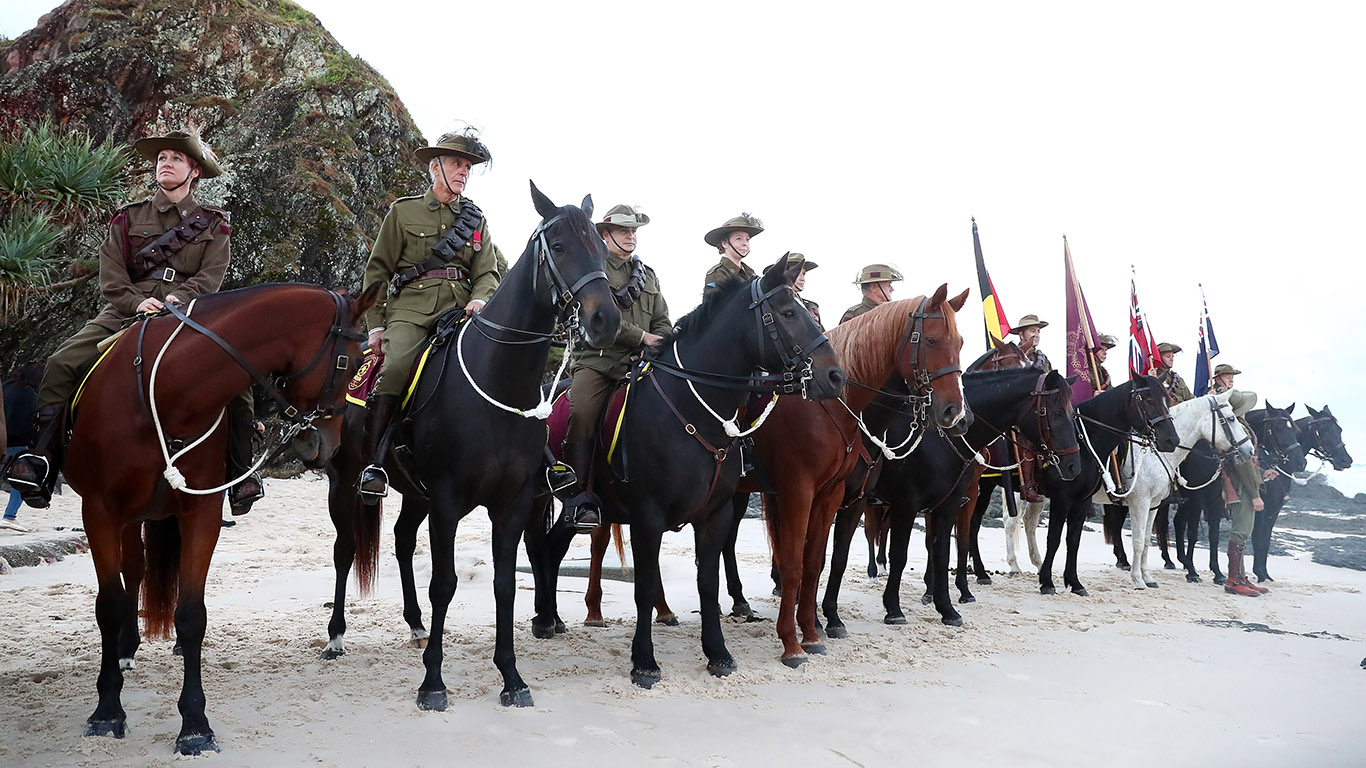
13. Australia
> Military expenditure: $27.5 billion
> Pct. change military expenditure, 2008-2017: +33.0%
> Expenditure as pct. of GDP: 2.0%
> Per-capita military expenditure: $1,123
Citing disputes in the South China Sea and a rise in terrorism in Europe, Australian leaders have opted to build up the island nation’s military. Australia spends 2% of its GDP on its military, and it has one of the highest per-capita military expenditures among countries on this list at $1,123. Of the 15 nations with the largest military budgets, only the U.S. and Saudi Arabia spend more on their armed forces per person than Australia.

12. Italy
> Military expenditure: $29.2 billion
> Pct. change military expenditure, 2008-2017: -17.0%
> Expenditure as pct. of GDP: 1.5%
> Per-capita military expenditure: $493
Unlike most countries on this list, Italy is cutting back on military spending. In the last decade, Italian military spending declined by 17% to $29.2 billion. That is the steepest drop of any country among the top 15 military spenders worldwide. However, Italian military spending could be on a bit of an upswing as the country started spending an increased amount of money procuring arms from domestic weapons manufacturers in 2016.
[in-text-ad-2]

11. Brazil
> Military expenditure: $29.3 billion
> Pct. change military expenditure, 2008-2017: +21.0%
> Expenditure as pct. of GDP: 1.4%
> Per-capita military expenditure: $140
As one of the largest nations in the world, Brazil also has one of the largest military budgets. Brazil spent $29.3 billion on its military in 2017, or 1.4% of its GDP that year. Men are required to serve in the Brazilian military for at least 10 months. Brazil is the only country in South America on this list. It is also unique from many of the other countries on this list in that much of its military resources are used to deal with issues within its own borders. Brazilian armed forces are often deployed to keep the peace in the country’s low-income neighborhoods known as favelas.
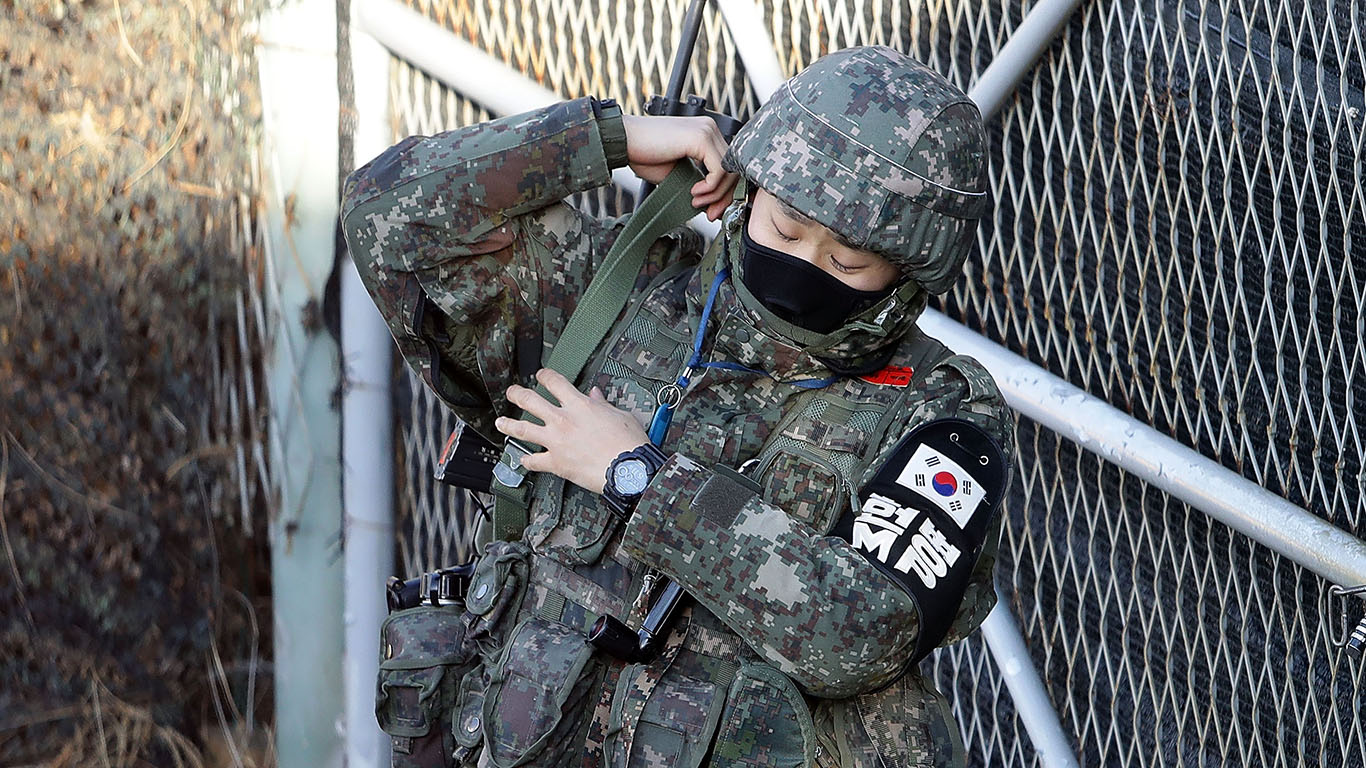
10. South Korea
> Military expenditure: $39.2 billion
> Pct. change military expenditure, 2008-2017: +29.0%
> Expenditure as pct. of GDP: 2.6%
> Per-capita military expenditure: $768
Still technically at war with its neighbor to the North, South Korea maintains a well-funded military. The country spent $39.2 billion on its military in 2017. South Korea requires men to serve in the armed forces for at least 21 months. Aggressive North Korean behavior, through displays such as missile testing, has been on the rise in recent years following the ascension of Kim Jong-un, but recent peace talks between the North and South offer renewed hopes for peace.
[in-text-ad]
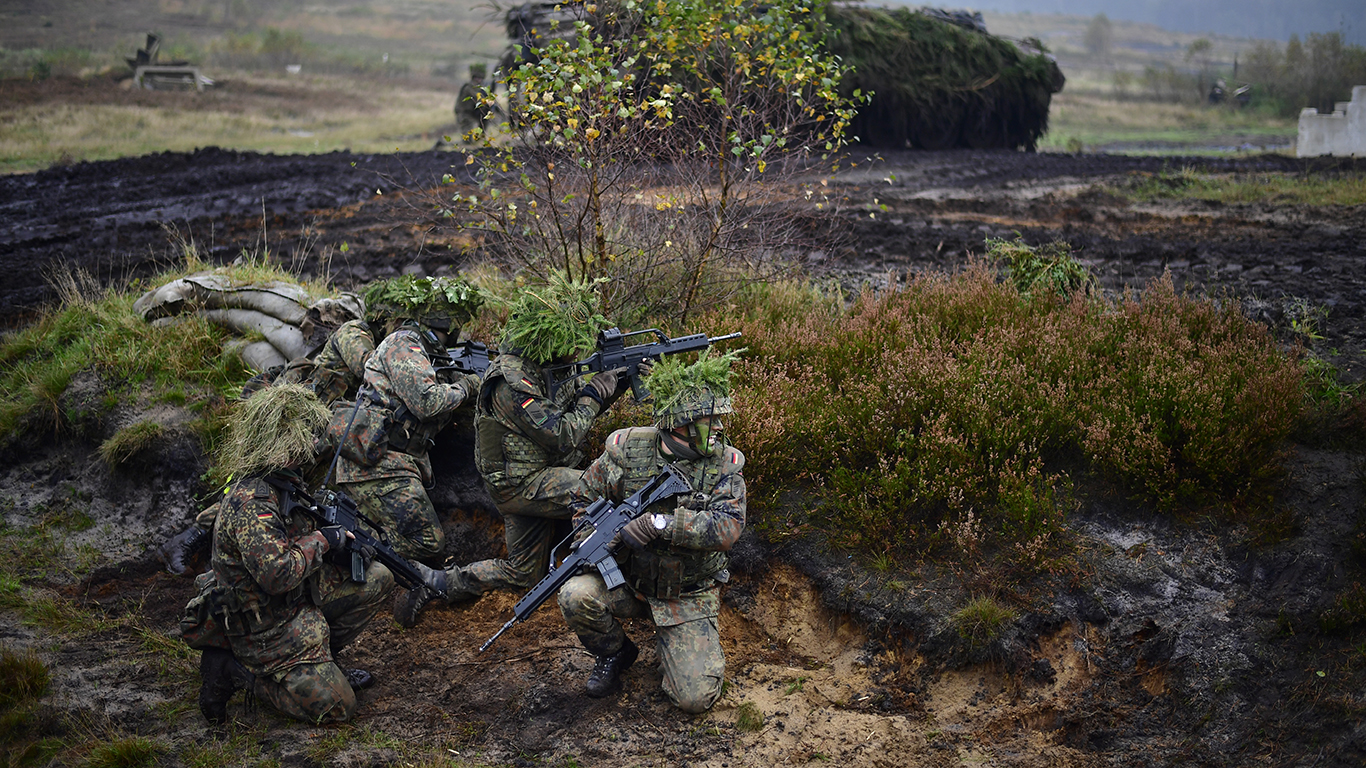
9. Germany
> Military expenditure: $44.3 billion
> Pct. change military expenditure, 2008-2017: +8.8%
> Expenditure as pct. of GDP: 1.2%
> Per-capita military expenditure: $540
Though Germany is Europe’s largest economy, it ranks behind countries like France and the U.K. in overall military spending. Germany spends 1.2% of its GDP on its armed forces, one of the lowest percentages among countries spending the most on their militaries. For context, France spends 2.3% of its GDP on the military, nearly double what Germany spends.

8. Japan
> Military expenditure: $45.4 billion
> Pct. change military expenditure, 2008-2017: +4.4%
> Expenditure as pct. of GDP: 0.9%
> Per-capita military expenditure: $356
Japan’s more than $45 billion military budget in 2017 accounted for less than 1% of its GDP that year. Of the 15 countries spending the most on their armed forces, Japan’s military expenditure as a percentage of its GDP, at 0.9%, is the lowest. Japan is a close military ally of the United States, and it hosts several U.S. military bases. However, the U.S. base in Okinawa is a source of contention between the two countries.
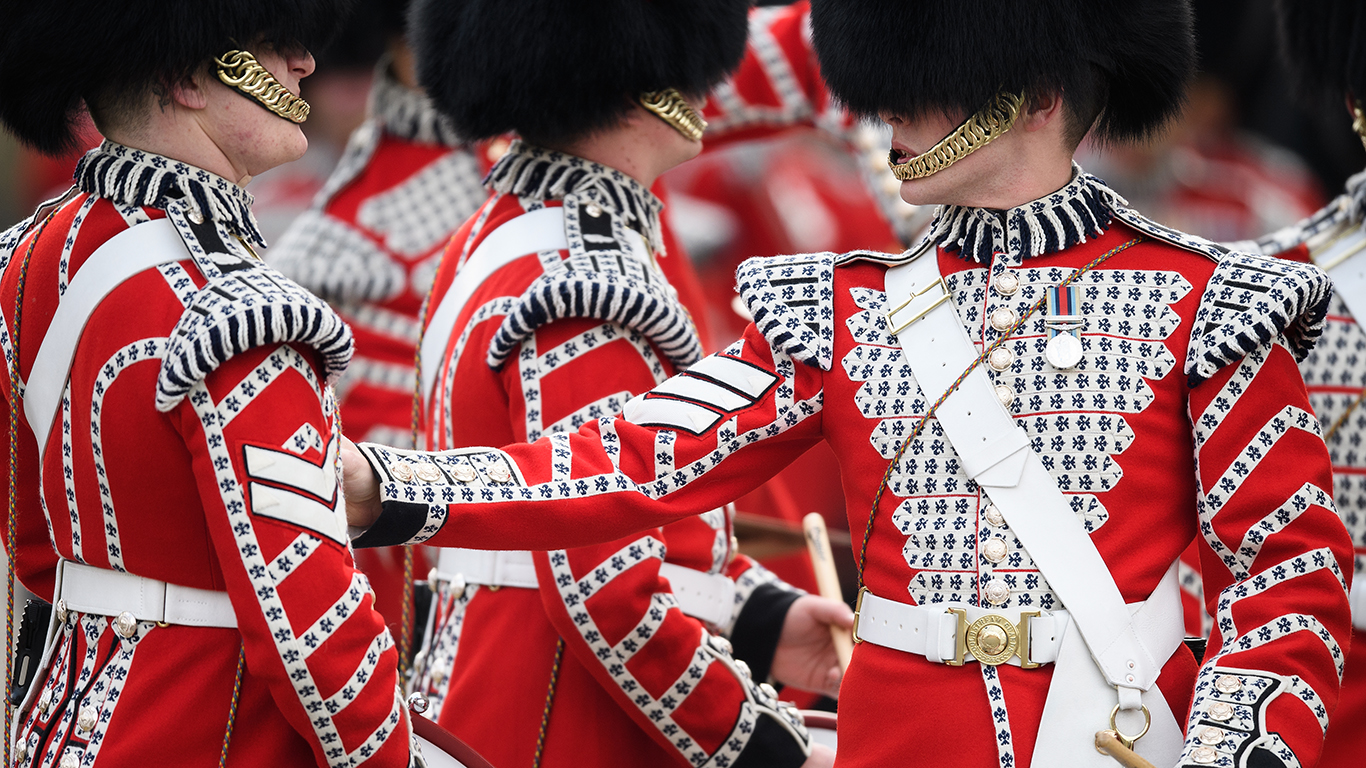
7. United Kingdom
> Military expenditure: $47.2 billion
> Pct. change military expenditure, 2008-2017: -15.0%
> Expenditure as pct. of GDP: 1.8%
> Per-capita military expenditure: $713
As a world leader and a key member of NATO, the U.K. military plays a crucial role in the transatlantic alliance. The U.K. government reduced its military spending as the Iraq War drew to a close, but the country announced in 2016 its intention to meet the NATO guidelines for its member nations to spend 2% of their GDPs on their militaries.
[in-text-ad-2]
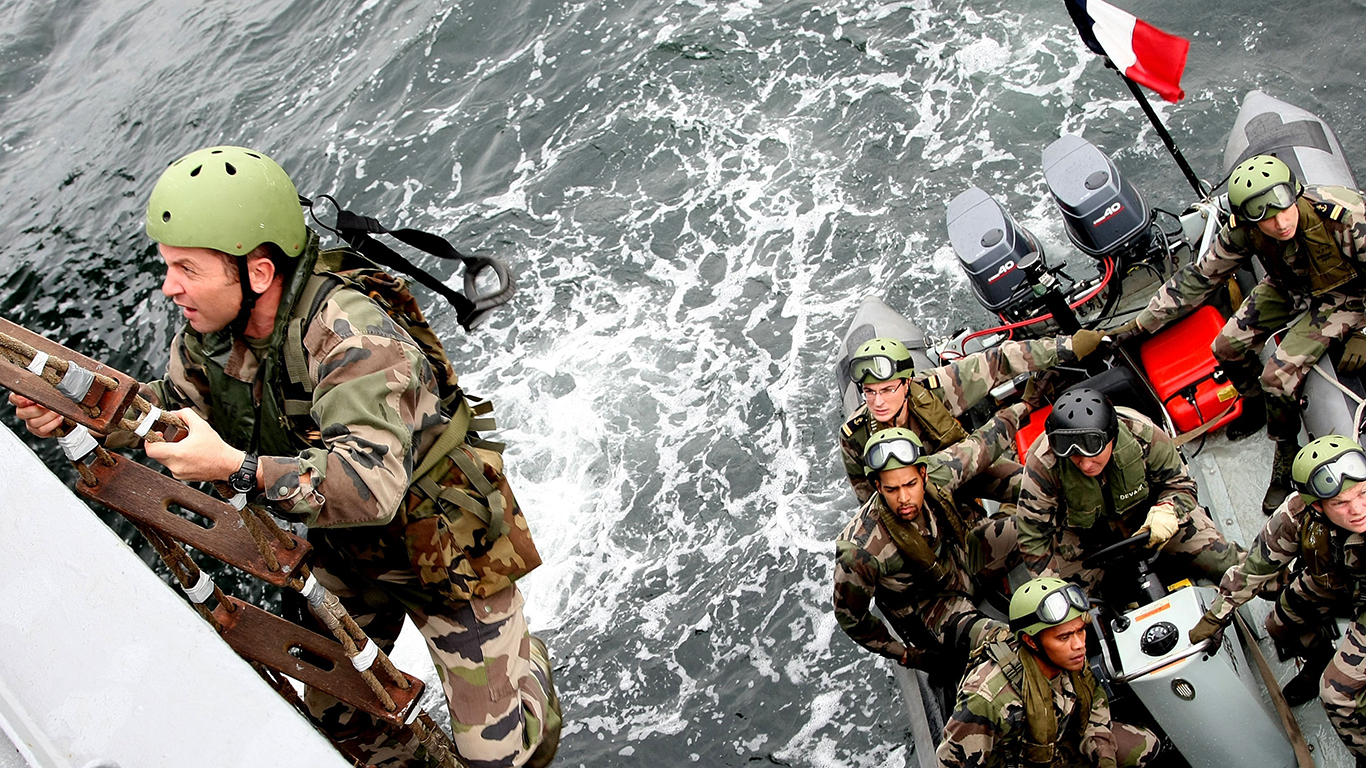
6. France
> Military expenditure: $57.8 billion
> Pct. change military expenditure, 2008-2017: +5.1%
> Expenditure as pct. of GDP: 2.3%
> Per-capita military expenditure: $889
The French military has continued to grow, largely in reaction to several recent terrorist attacks in the country. Thousands of French armed forces members now patrol the streets of major cities like Paris to deter and defend against any further attacks. France spent $57.8 billion on its military in 2017, well above any other European country. Its military spending amounts to 2.3% of its GDP and is above the NATO spending guideline of 2% of GDP.
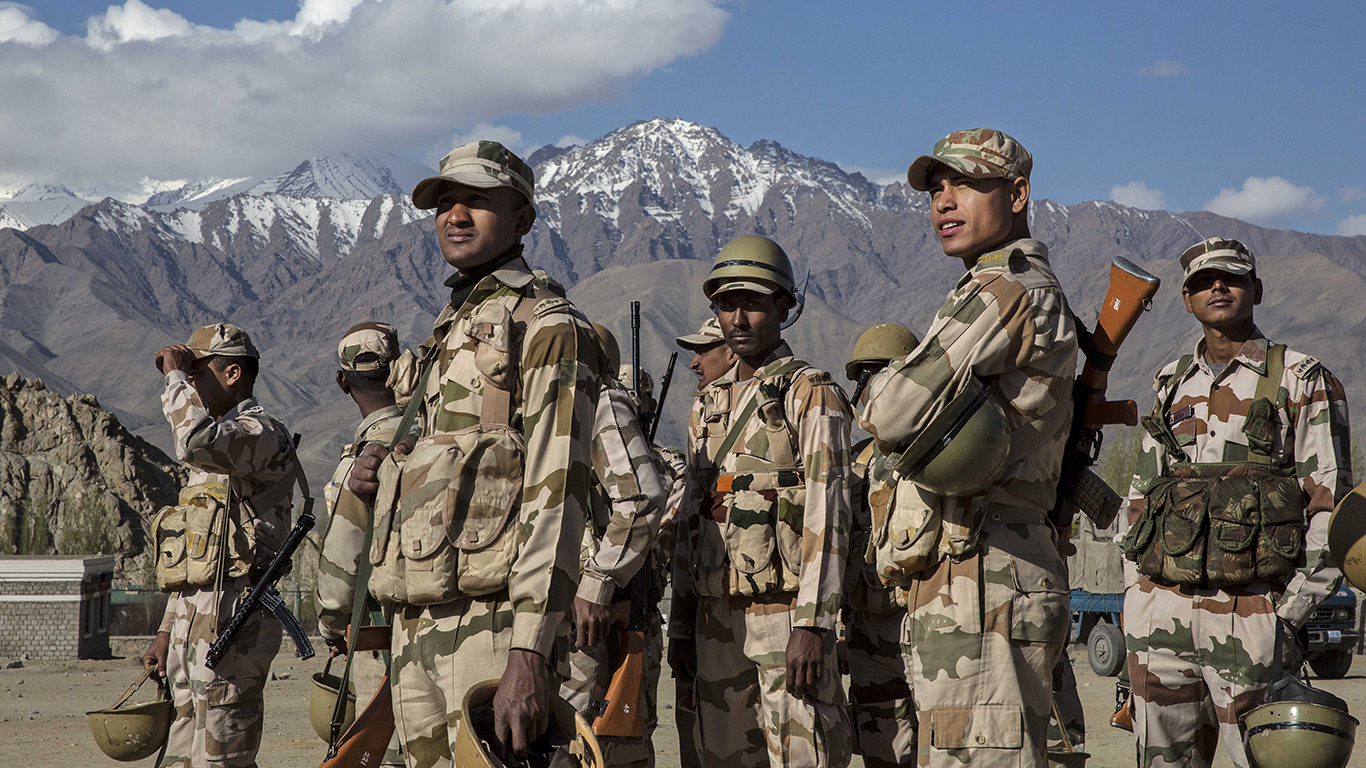
5. India
> Military expenditure: $63.9 billion
> Pct. change military expenditure, 2008-2017: +45.0%
> Expenditure as pct. of GDP: 2.5%
> Per-capita military expenditure: $48
Though India spends just $48 per person on its military, far less than any other country on this list, the nation of over 1.3 billion people is still among the top military spenders in the world. India has continued to build up its military amid a long-running dispute with neighbor Pakistan. Both countries may be ramping up their nuclear weapons, which could partially explain India’s above-average military expenditure as a percentage of its GDP.
[in-text-ad]

4. Russia
> Military expenditure: $66.3 billion
> Pct. change military expenditure, 2008-2017: +36.0%
> Expenditure as pct. of GDP: 4.3%
> Per-capita military expenditure: $461
Russian President Vladimir Putin announced in 2011 a $360 billion plan to revamp Russia’s military. In the past 10 years, Russia’s military spending increased by 36%. Despite its aim to update its military might, Russian spending dropped sharply from 2016 to 2017, largely because of economic difficulties in the country. Russia was involved, either directly or indirectly, in several armed conflicts over the last few years, including fighting in the Crimean Peninsula. Today, Russia also backs Syrian President Bashar al-Assad in the ongoing Syrian Civil War.
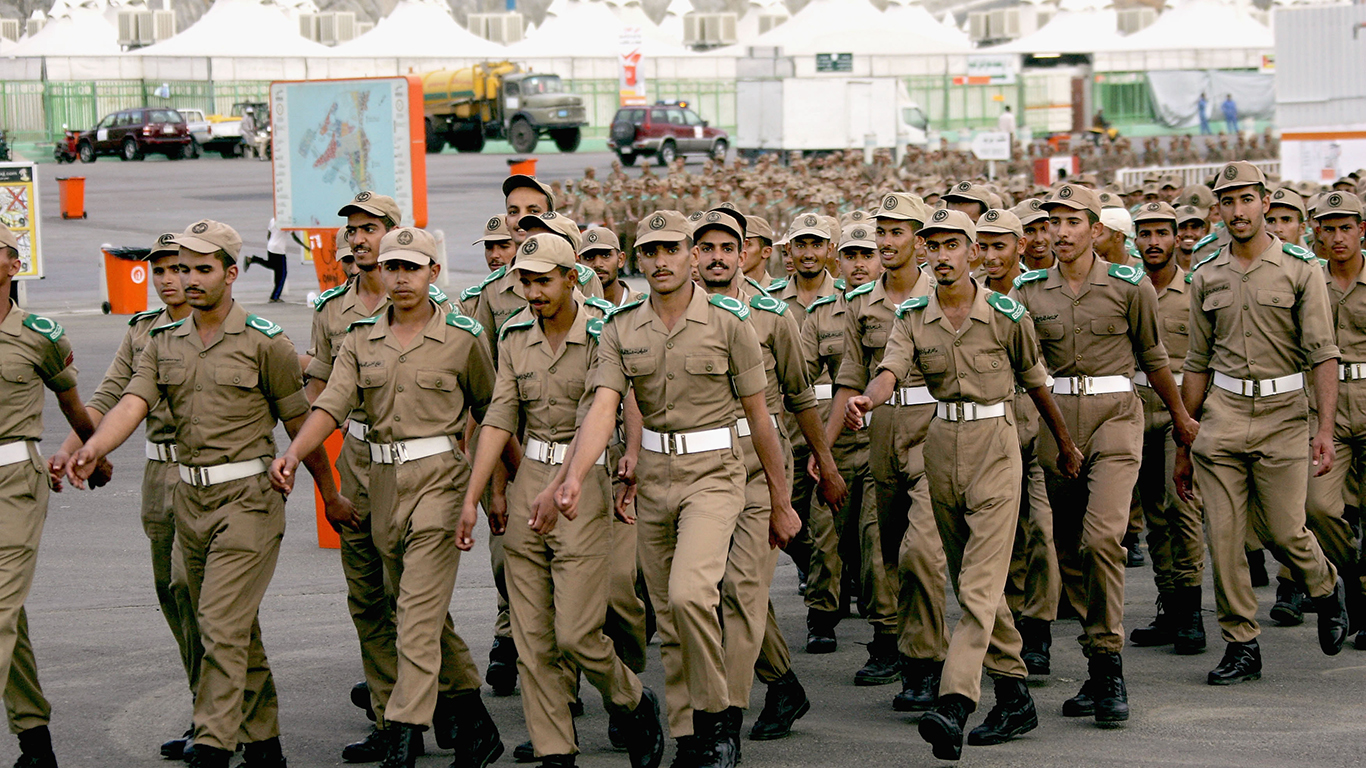
3. Saudi Arabia
> Military expenditure: $69.4 billion
> Pct. change military expenditure, 2008-2017: +34.0%
> Expenditure as pct. of GDP: 10.0%
> Per-capita military expenditure: $2,107
Saudi Arabia has both the means and the need to increase its military power. The oil-rich nation is one of the world’s wealthiest. It also is located near several armed conflicts, including in Syria and Yemen, the latter of which it is a participant in. The nation also faces terrorist threats from groups like ISIS. The Saudi government spent $69.4 billion on its military in 2017, and it appears the nation will continue to strengthen its armed forces.
The country secured an arms deal worth over $1 billion with the United States in March 2018. The United States will supply its Middle Eastern ally with nearly 6,700 missiles as well as maintenance equipment for Abrams tanks and helicopters. Saudi Arabia spends 10% of its GDP on its military, by far the highest percentage of any country on this list and one of the highest in the world.
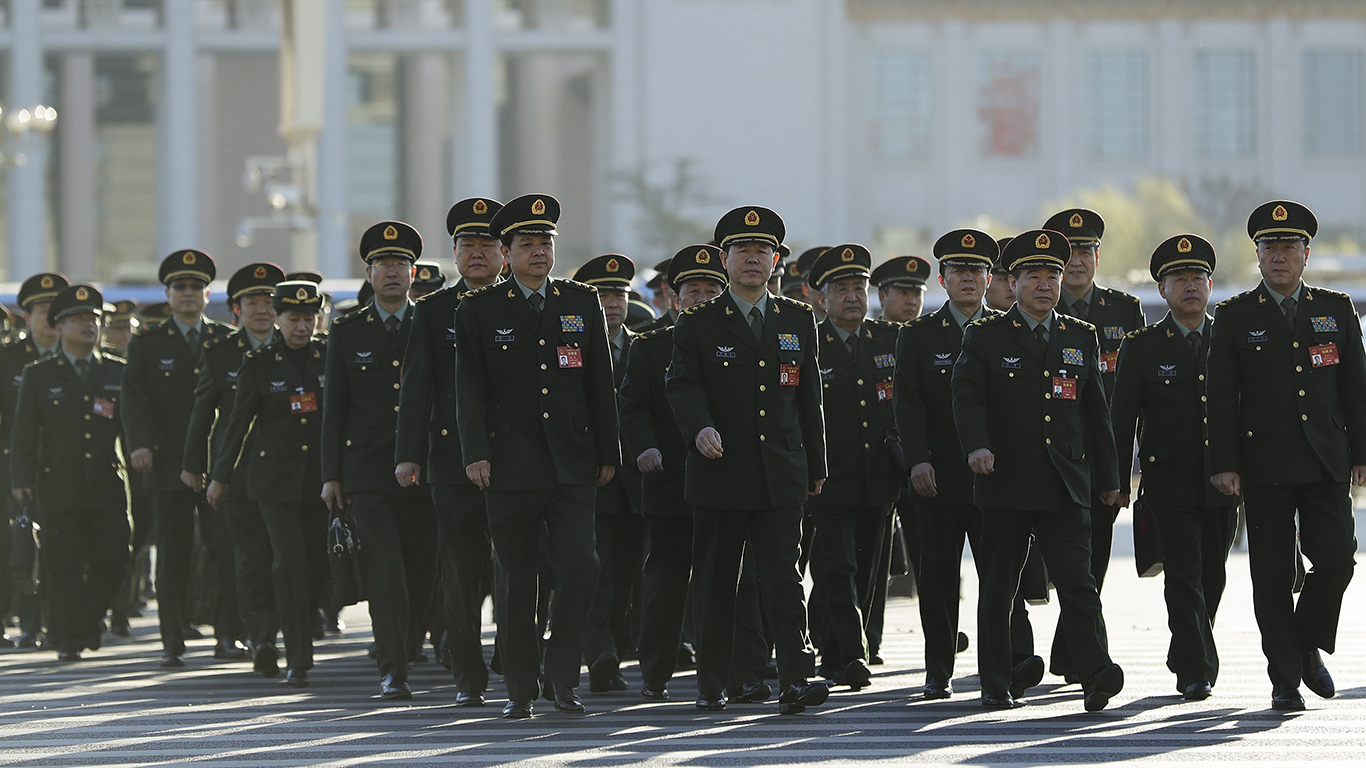
2. China
> Military expenditure: $228.0 billion
> Pct. change military expenditure, 2008-2017: +110.0%
> Expenditure as pct. of GDP: 1.9%
> Per-capita military expenditure: $162
No major military power has ramped up its military like China in the past decade. Since 2008, China more than doubled its annual military expenditures, spending $228 billion in 2017. The world’s most populous nation has more troops in its armed forces than any other country on Earth with more than 2 million as it requires males ages 18-24 years old to serve in the military for at least two years. China is also bulking up its navy. It is currently building its third aircraft carrier.
[in-text-ad-2]
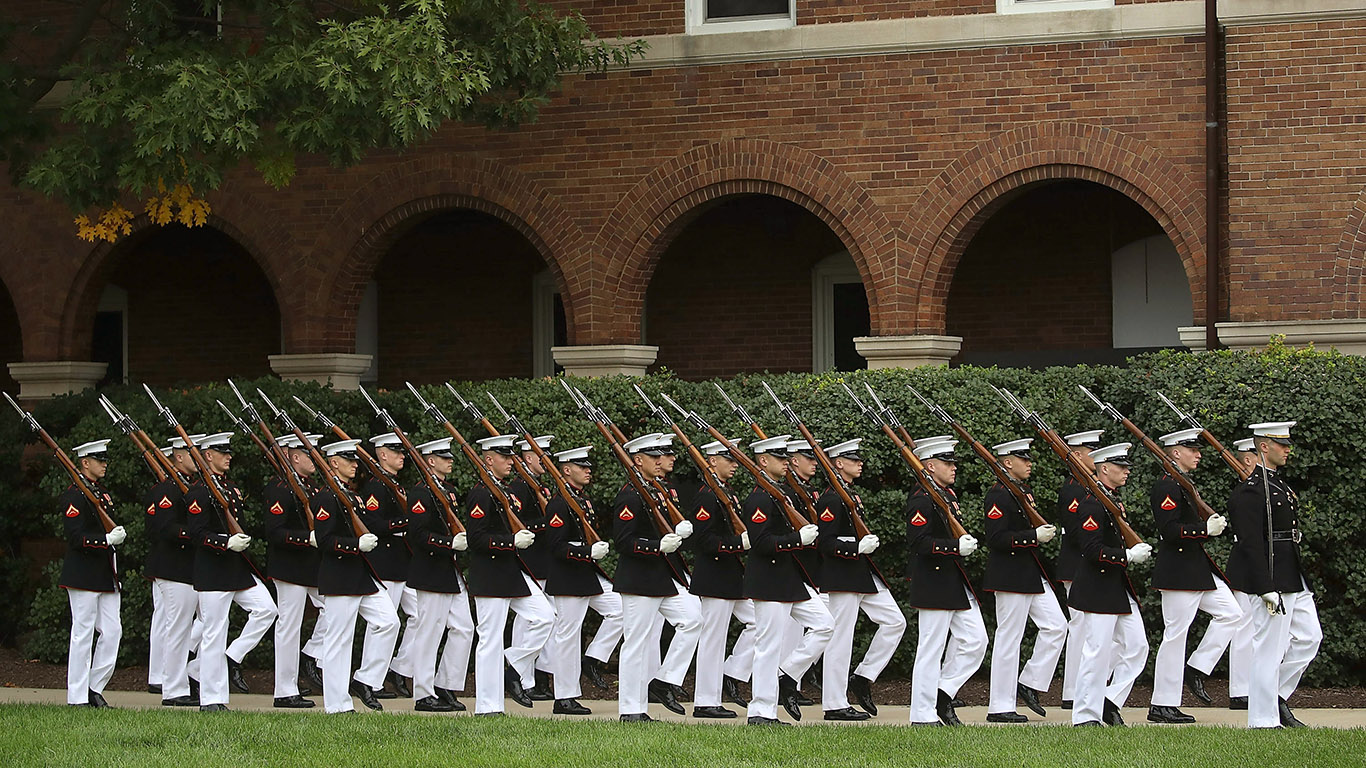
1. United States
> Military expenditure: $610.0 billion
> Pct. change military expenditure, 2008-2017: -14.0%
> Expenditure as pct. of GDP: 3.1%
> Per-capita military expenditure: $1,879
The United States has by far the best funded military in the world. The U.S. government spends more on its military than the next seven highest-spending countries combined. More than one-third of the world’s entire military spending comes from the United States. The American military’s footprint can be found in hundreds of bases in dozens of countries around the world. Though it still spends far more than any other country, America’s $610 billion military expenditure in 2017 was 14% lower than it was 10 years ago. The decrease was likely the result of the end of the Iraq War.
Detailed findings & methodology:
Many of the other countries on this list are U.S. allies. Countries like France, Germany, Italy, the U.K., and Canada are members of the North Atlantic Treaty Organization, or NATO. The United States also works closely with other countries on this list, such as South Korea, Saudi Arabia, and Japan.
Most of the countries on this list spend between 1% and 3% of their gross domestic product annually on their military. Some countries spend a larger share, like the United States at 3.1%, Russia at 4.3%, and Saudi Arabia at 10.0%.
Each of the 15 countries spending the most on their militaries in 2017 were also in the top 15 in 2016, though the order changed slightly. Saudi Arabia moved from fourth to third, switching places with Russia. Italy and Australia were 11th and 12th, respectively, in 2016. Both were leapfrogged by Brazil in 2017, which went from 13th to 11th. India and France traded places as well, with India moving from fifth to sixth.
Israel and the United Arab Emirates were listed as the 15th- and 14th-highest spending countries, respectively, in the 2016 version of this report. But as more information became available, SIPRI revised its 2016 ranking, determining that Turkey and Canada actually outspent Israel and the UAE in 2016, as they did in 2017.
In order to determine the countries spending the most on war, 24/7 Wall St. reviewed estimated military spending from the Stockholm International Peace Research Institute, or SIPRI, in its “Trends in World Military Expenditure” report. Spending as a share of GDP, per-capita expenditure, and absolute spending figures for 2017 and 2008 also came from SIPRI. Military expenditure includes current military forces and activities, including salaries and benefits, operational expenses, arms and equipment purchases, military construction, research and development, central administration, command, and support.
The thought of burdening your family with a financial disaster is most Americans’ nightmare. However, recent studies show that over 100 million Americans still don’t have proper life insurance in the event they pass away.
Life insurance can bring peace of mind – ensuring your loved ones are safeguarded against unforeseen expenses and debts. With premiums often lower than expected and a variety of plans tailored to different life stages and health conditions, securing a policy is more accessible than ever.
A quick, no-obligation quote can provide valuable insight into what’s available and what might best suit your family’s needs. Life insurance is a simple step you can take today to help secure peace of mind for your loved ones tomorrow.
Click here to learn how to get a quote in just a few minutes.
Thank you for reading! Have some feedback for us?
Contact the 24/7 Wall St. editorial team.